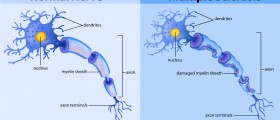
Signs and symptoms of multiple sclerosis
The exact signs and symptoms usually differ from one patient to another. An affected person may suffer almost every neurological symptom: changes in sensation, weakness of the muscles, spasms of the muscles, difficulty walking and moving, difficulties with coordination and balance, speech problems, problems with feeding and swallowing, pain, bladder and bowel problems. All of the systems of the body are affected with this disease, but the exact symptoms vary depending on what regions of brain are most affected.
What causes multiple sclerosis and how can one prevent it?
Multiple sclerosis is most probably a result of combination of genetic, environmental and infectious factors. Some of the experts even suggest that certain vascular problems may also increase one’s risk from multiple sclerosis. Multiple sclerosis is not a hereditary disease, but certain genetic variations can increase one’s risk of developing the disease. Familial recurrence rate of multiple sclerosis is somewhere around 20%.
Various environmental factors are also associated with multiple sclerosis. For example, living in countries with temperate climates, far from the equator, is considered one of the risk factors. Decreased sun exposure may be linked with multiple sclerosis because people living in these regions have decreased vitamin D production.
This is an autoimmune disease, and therefore, increased stress is considered as a high risk factor. Smoking and exposure to toxins may probably contribute to the development of this disease. Other possible risk factors include poor diet and hormonal intake.
There is no way to prevent multiple sclerosis, because it is caused by the combination of factors. However, early detection of this disease and involvement in a therapy, may prevent the most severe symptoms of the disease, and help the patient to lessen the number of relapsing symptoms.

















Your thoughts on this
Loading...